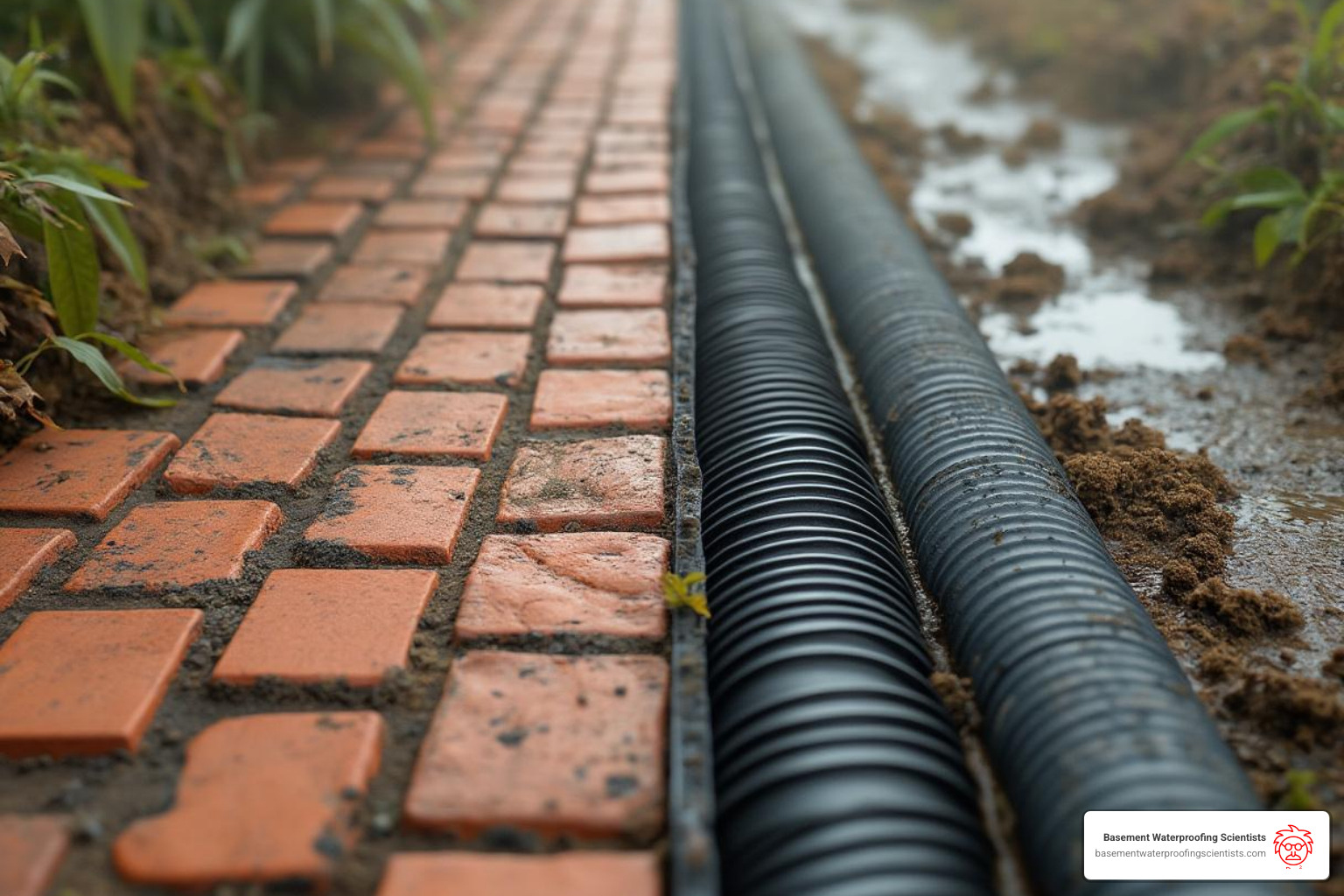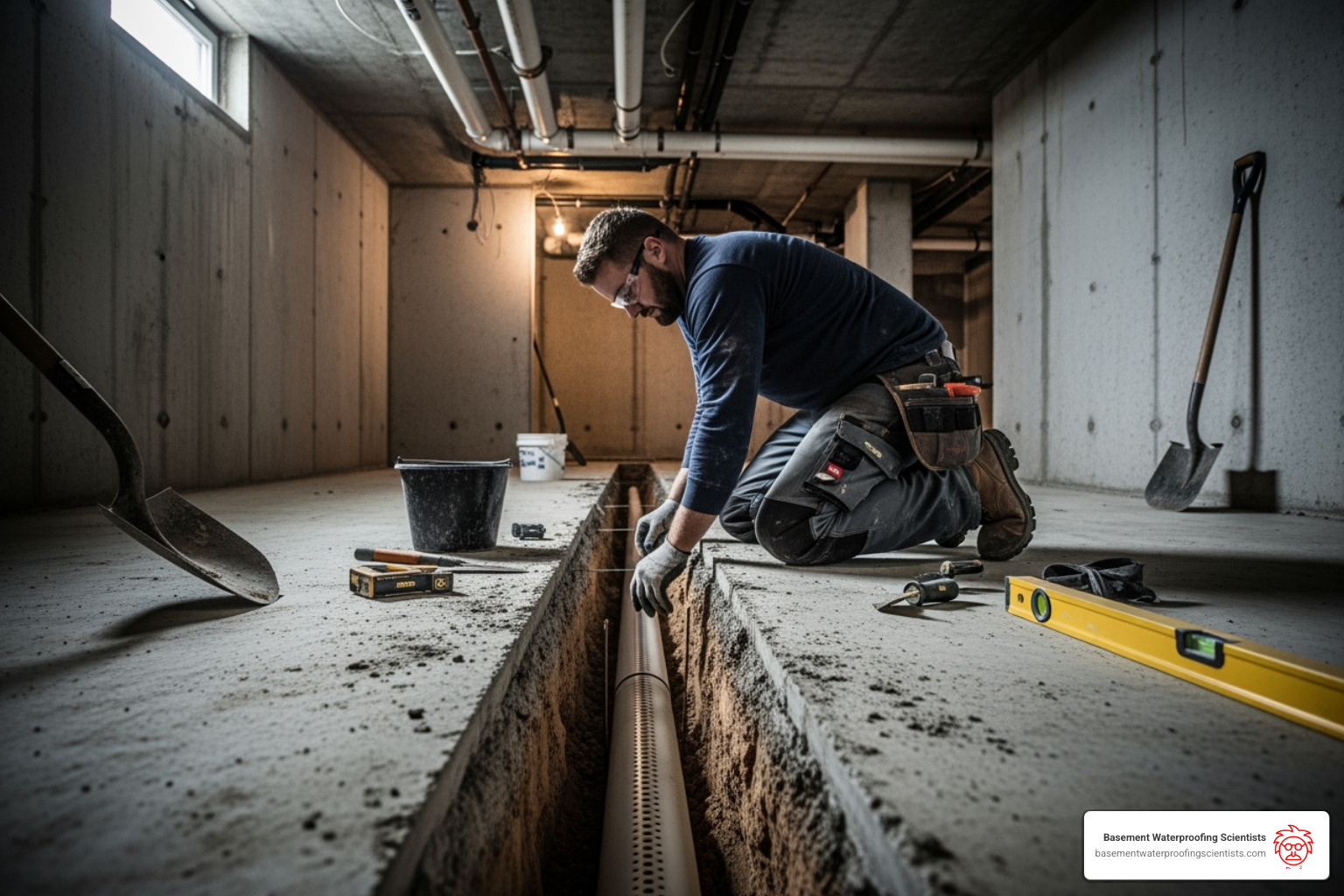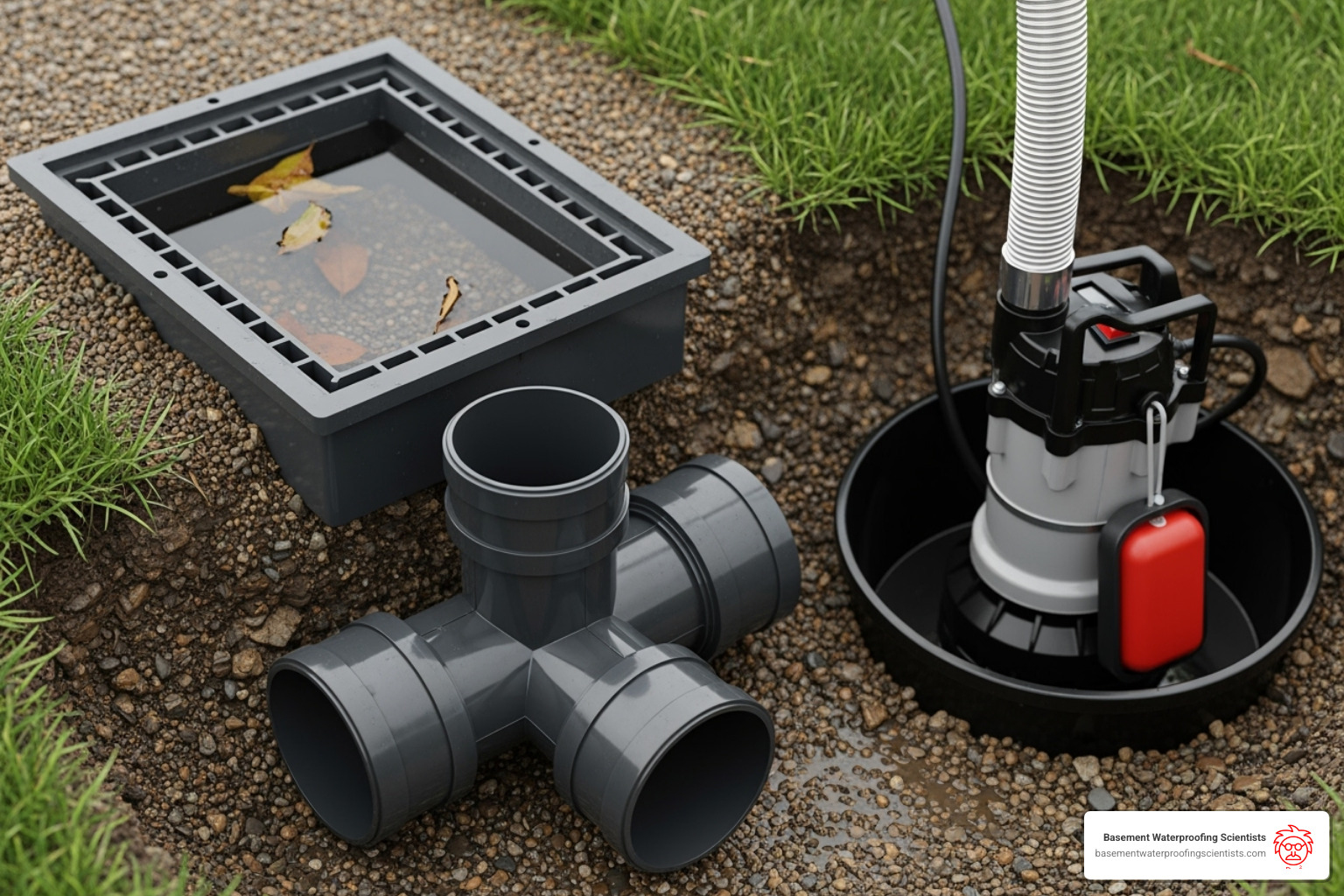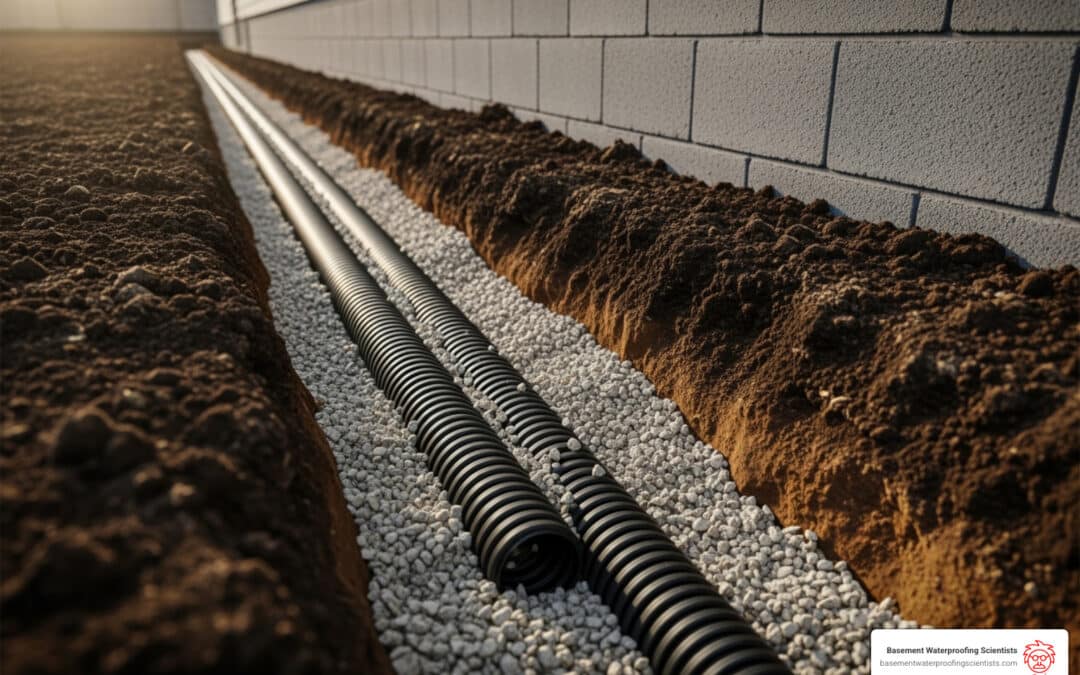Understanding Drainage Tile Systems
A drainage tile system is a powerful solution for managing unwanted water around your home. If your basement is persistently wet, this time-tested method is often the answer.
- What it is: A network of specialized, buried pipes that collects excess water from the soil, acting like an underground gutter system.
- What it does: It prevents water from accumulating around your foundation by capturing it and redirecting it to a sump pump or a safe discharge area away from your home.
- Why it’s vital: By controlling groundwater, drainage tile prevents costly foundation damage, stops basement leaks, and keeps your living spaces dry and healthy. It can transform a damp, unusable basement into a functional part of your home.
Persistent moisture can lead to musty smells, mold, and structural issues. This guide will explain everything about drainage tile, from how it works to why it might be the perfect solution for your water problems.
I’m Darin Garvey, a leader at Basement Waterproofing Scientists. With over 30 years of combined experience, my team provides state-of-the-art leak detection and targeted drainage tile solutions to ensure our clients have dry, safe, and healthy basements.

What is Drainage Tile and How Has It Evolved?
The Primary Function of Drainage Tile
A drainage tile system works silently underground to protect your home from water. It’s a network of specialized pipes buried around your foundation designed to intercept and redirect excess groundwater. Its main job is to manage subsurface water, preventing it from building up and creating hydrostatic pressure against your foundation walls and floor.
The system creates an easy path for water to follow. As groundwater moves through the soil, it enters the perforated pipes. Gravity and a gentle slope then guide the water to a designated collection point, typically a sump pit. From there, a sump pump expels the water safely away from your home. This process effectively lowers the water table around your foundation, preventing water seepage, mold growth, and potential structural damage.
You might hear drainage tile called a French drain, weeping tile, or perimeter drain, but the goal is always the same: collect and channel water away to keep your home dry. To learn more about how these systems work, see our page on More info about basement drainage systems.
From Clay to Plastic: The Evolution of Materials
The concept of subsurface drainage dates back to ancient Rome, but it was popularized in the U.S. in 1838 by farmer John Johnston, who used it to dramatically increase his crop yields. You can learn more about this history on the John Johnston, the “father of tile drainage” page.
For over a century, these systems used sections of fired clay tiles or precast concrete tiles laid end-to-end. The gaps between them allowed water to seep in. This is where the name “drainage tile” originated, even though modern systems use pipes.
Then, the 1970s revolutionized the industry with the introduction of corrugated plastic pipe made from HDPE tubing or PVC pipe.

This shift to plastic offered significant advantages:
- Durability: Plastic is far less brittle than clay or concrete.
- Flexibility: Corrugated pipes can bend around obstacles, simplifying installation.
- Cost-Effectiveness: Plastic is less expensive to produce and install.
- Efficiency: Modern pipes come in long rolls, requiring fewer connections, and can be wrapped in a filter fabric to prevent clogs.
Today, advanced plastic materials are the standard for residential drainage tile systems, making them more reliable and efficient than ever.
Types of Drainage Systems and Their Applications
Drainage tile systems are versatile, with applications ranging from protecting home foundations to improving farmland. The design varies based on the goal, but the principle of managing excess water remains the same.
Residential Drainage Systems: Protecting Your Home
For homeowners, a drainage tile system can transform a damp, unusable basement into a dry, comfortable living space. The two main types are exterior and interior systems.
| Feature | Exterior Drainage System | Interior Drainage System |
|---|---|---|
| Typical Cost | $20 to $60 per linear foot | $60 to $100 per linear foot |
| Installation Disruption | Significant (extensive excavation outside) | Minimal (inside basement, no major landscaping disruption) |
| Effectiveness | Good for surface water; prone to clogging | Excellent for hydrostatic pressure; clog-resistant design |
| Maintenance | Difficult to service without re-excavation | Easy to access and maintain |
Exterior systems are installed around the outside of the foundation footing. This requires major excavation, which is disruptive to landscaping and expensive. Over time, these systems are prone to clogging from soil and silt, and repairs require re-excavation.
Interior systems are our preferred solution for existing homes with water problems. A trench is cut into the basement floor along the perimeter, a pipe is laid in gravel, and the floor is re-concreted. This method is less disruptive, highly effective at relieving hydrostatic pressure, and much easier to service. Water is channeled to a sump pit for safe removal by a Basement Sump Pump Installation.
These systems are also essential for keeping crawl spaces dry. A well-designed Crawl Space Drainage System prevents moisture-related issues like mold and structural damage. Understanding how these components work with a basement floor drain provides a complete picture of home water management.
Agricultural Drainage Systems: Enhancing Farmland
While our focus is residential, it’s worth noting the agricultural roots of drainage tile. Farmers use subsurface drainage to manage the water table in their fields. By installing networks of perforated pipes, they can prevent waterlogged soil, which improves soil health and allows for deeper root growth. This leads to significant benefits, including earlier planting times and increased crop yields. For those interested in the details of farm drainage, the US Environmental Protection Agency provides a comprehensive overview.
The Complete Guide to Drainage Tile Installation
Knowing when and how to install a drainage tile system is key. Recognizing the warning signs is the first step for any homeowner.
Signs You Need a Drainage System
Your home will often signal that it has a groundwater problem. Look for these common clues:
- Wet Basement Walls: Damp spots, stains, or active water trickles after rain.
- Water Seeping from the Floor: Puddles or water coming up through cracks in the concrete.
- Musty Odors: A persistent damp, earthy, or moldy smell.
- Mold or Mildew: Visible growth on walls, floors, or stored items.
- Efflorescence: White, powdery mineral deposits left on concrete or masonry walls.
- Foundation Cracks: Especially horizontal or stair-step cracks that may be seeping water.
- Puddles in Yard: Consistently soggy areas near your foundation.
If your gutters are clear but these issues persist, a drainage tile system is likely the solution. You can learn more about how different drainage components work together in our guide on What Exactly Does A Basement Floor Drain Do?.
The Installation Process and Key Design Factors
A professional drainage tile installation is a precise process. Here’s a general overview of how an interior system is installed:

- Trenching: We cut a trench around the perimeter of the basement floor, where the floor meets the wall.
- Slope: The trench is graded with a consistent, gentle slope (at least 1/8 inch per foot) toward the sump pit. This is critical for ensuring water flows away and doesn’t stagnate.
- Pipe Placement: A 4-inch perforated drainage tile pipe is laid in the trench.
- Gravel Backfill: The pipe is surrounded by clean, washed gravel (typically 3/4-inch). The gravel filters out silt and debris while allowing water to flow freely to the pipe.
- Sump Pit: The pipe system terminates at a sump pit, a basin installed in the lowest part of the basement to collect the water.
- Discharge: A sump pump in the pit automatically pumps the water out of the basement and away from the foundation.
- Concrete Finish: The trench is sealed with fresh concrete, restoring your floor to a clean, finished state.
Factors like soil type also influence the design. For more on the process, see our guide on More info on French Drain Installation.
Cost Analysis and DIY Considerations
Residential interior systems typically range from $60 to $100 per linear foot, while exterior systems can run from $20 to $60 per linear foot. Though the per-foot cost for exterior systems seems lower, the required excavation often makes the total project cost much higher. The average professional basement waterproofing project costs between $4,000 and $8,000.
While a DIY installation is technically possible, we strongly advise against it for basement systems. The work is physically demanding and requires precision. A mistake in grading the slope can cause the entire system to fail, leading to more costly repairs. Professionals have the experience and equipment to steer building codes, like the International Residential Code (IRC), and ensure a lasting solution. For a detailed breakdown, visit our Drain Tile Installation Cost page.
Balancing Benefits with Environmental Considerations
A drainage tile system offers transformative benefits for your home. It’s also important to understand how these systems interact with the environment.
Key Benefits of a Residential Drainage Tile System
Installing a drainage system provides immediate and long-lasting advantages:
- A Dry, Usable Basement: The most obvious benefit is changing a damp, flood-prone area into a dry, functional living space for a family room, office, or storage.
- Structural Protection: By relieving hydrostatic pressure, the system prevents foundation cracks, bowing, and other costly structural damage.
- Improved Air Quality: Eliminating moisture prevents musty odors and the growth of mold and mildew, creating a healthier home environment.
- Increased Property Value: A dry basement is a major selling point, making your home more attractive to potential buyers.
- Peace of Mind: A reliable system ends the anxiety that comes with heavy rain, allowing you to relax knowing your home is protected.
Our interior drainage systems deliver these benefits with minimal disruption to your home and yard.
Agricultural and Environmental Considerations
In agriculture, drainage tile is crucial for boosting crop yields by preventing soil oversaturation. This allows for earlier planting and more efficient fertilizer use, with a strong return on investment for farmers. For more details, see this guide on understanding tile drainage benefits.
While residential systems have minimal environmental impact, large-scale agricultural drainage can affect water quality by transporting nutrients like nitrates into waterways. The agricultural industry has developed effective mitigation strategies to address this, such as controlled drainage, which you can learn about from Controlled Drainage research, as well as bioreactors and saturated buffers that filter runoff. For homeowners, the key is ensuring water is discharged responsibly to prevent erosion or issues for neighbors.
Essential Accessories and System Maintenance
A drainage tile system relies on several key components and routine maintenance to function effectively for years.

Key accessories include:
- Sump Pump: The heart of a basement system. It sits in a sump pit and automatically pumps collected water out and away from your home.
- Catch Basins: Grated boxes installed at ground level to collect surface water and debris before it can clog the main drainage lines.
- Wye Fittings: Y-shaped connectors that merge separate drainage lines into a single pipe for efficient water flow.
- Filter Socks: Fabric sleeves that wrap around perforated pipe to block silt and fine particles. They are useful but can clog over time, which is one reason interior systems are often preferred.
- Waterproofing Membranes: Applied to exterior foundation walls, these work with drain tile to provide an additional barrier against water seepage.
System Maintenance
Modern interior drainage tile systems are low-maintenance, but a few simple checks ensure their longevity.
- Inspect the Sump Pit: Periodically check that the pit is clear of debris. During heavy rain, listen for the pump to run.
- Test the Sump Pump: Every few months, pour a bucket of water into the pit to ensure the pump activates, discharges the water, and shuts off properly. If it fails, call a professional immediately.
- Prevent Clogs: Keep surface inlets and catch basins clear of leaves and debris. For exterior systems, be mindful of tree root intrusion, which can block pipes. This is not a concern for interior systems.
- Schedule Professional Check-ups: If you notice any signs of water returning, have an expert inspect your system. Our team can assess the health of your drainage tile and pinpoint any issues.
Conclusion
A drainage tile system is one of the most reliable ways to protect your home from water damage. Evolving from simple clay tiles to modern, efficient plastic pipes, these systems work by intercepting groundwater and redirecting it safely away from your foundation.
By addressing the root cause of wet basements—hydrostatic pressure—a properly installed drainage tile system provides numerous benefits. It gives you a dry, usable basement, protects your home’s structural integrity, improves indoor air quality, and increases your property value. Most importantly, it delivers peace of mind every time it rains.
An investment in a professional waterproofing system, typically between $4,000 and $8,000, pays for itself in protection and comfort. It’s about taking control of your home’s environment and ensuring it remains a safe, healthy space.
At Basement Waterproofing Scientists, we have over 30 years of experience installing drainage tile systems across Pennsylvania, New Jersey, and Delaware. Our specialized equipment allows us to identify leak sources precisely, providing targeted solutions backed by a lifetime guarantee.
Ready to solve your basement water problems for good? Learn more about our comprehensive basement drain systems and let us design a custom solution to keep your foundation permanently dry.


